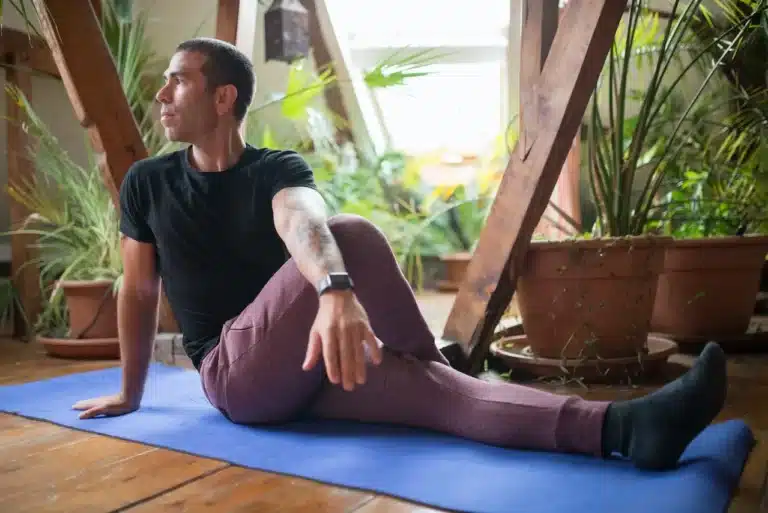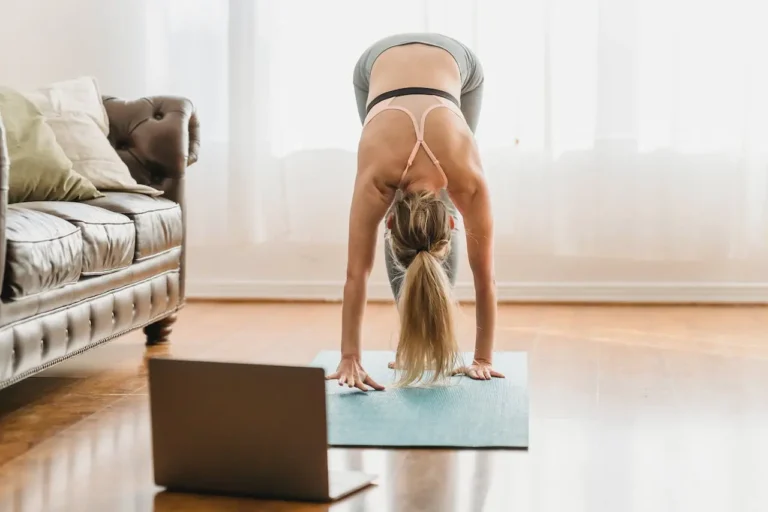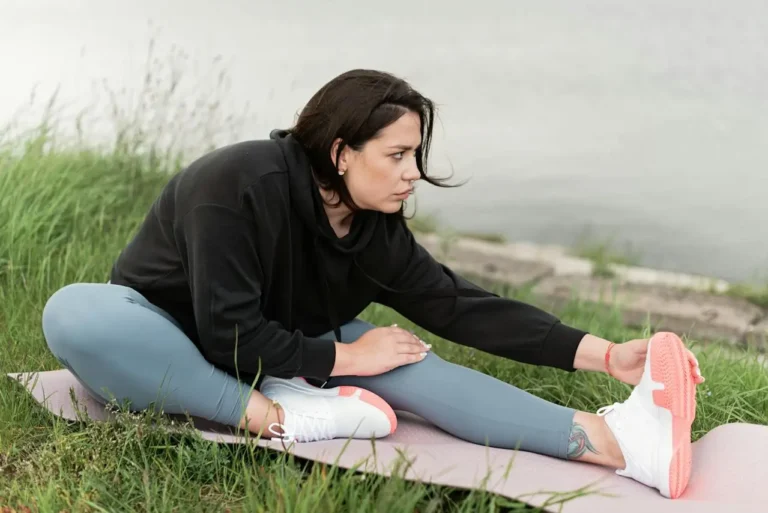The Comfort Of Sleeping On A Yoga Mat – Wake Up Refreshed!

Are you tired of tossing and turning all night long? Do you wake up feeling groggy and unrested? Perhaps it’s time to consider a new sleeping surface – a yoga mat!
Yes, that’s right – you can get a good night’s sleep on a yoga mat and wake up feeling refreshed and rejuvenated. Not only is it affordable, but it’s also a fantastic option for those looking to achieve ultimate comfort while sleeping.
Why choose a yoga mat as a sleeping pad?
Sleeping on a yoga mat may not be the first choice for many people, but it can offer various benefits that traditional sleeping pads do not. For starters, yoga mats are designed to provide comfort and support during yoga practice, which makes them an ideal alternative for sleeping. Here are some reasons why you might want to consider a yoga mat as a sleeping pad:
Comfort
Yoga mats are made to be comfortable and cushioned, which means they can provide a soft sleeping surface that conforms to your body shape. Unlike traditional sleeping pads that can be too firm or too thin, yoga mats have just the right amount of padding to keep you comfortable all night long.
Versatility
Yoga mats come in various sizes and shapes, making them easy to pack and carry. They are lightweight and can be rolled up tightly, making them a convenient option for camping trips. Additionally, yoga mats can also be used for other activities, such as meditation or stretching, which makes them a versatile tool for any outdoor enthusiast.
“Yoga mats are designed to provide comfort and support during yoga practice, which makes them an ideal alternative for sleeping.”
Using a yoga mat as a sleeping pad can be a great option for those who want to save money or are looking for an alternative sleeping surface. However, it’s worth noting that yoga mats may not be suitable for everyone, especially those with specific sleeping needs or health concerns. In such cases, it’s best to consult a healthcare provider or a sleep specialist for advice.
Types of Sleeping Pads and their Benefits
When it comes to sleeping pads, there are several options available in the market. Each type of sleeping pad is designed to provide specific benefits to suit various sleeping styles and preferences. Here are four types of sleeping pads and their unique features:
| Sleeping Pad | Features | Benefits |
|---|---|---|
| Foam Pad | Lightweight, durable, easy to pack | Provides good insulation, ideal for backpacking |
| Air Mattress | Comfortable, adjustable firmness | Provides a cushioning effect, mimicking the feeling of sleeping on a regular mattress |
| Closed-cell Foam | Compact, waterproof, insulating, durable | Good for winter camping, water activities, and rock climbing |
| Self-Inflating Sleeping Pads | Mixture of foam and air, adjustable firmness | Combines the benefits of foam and air pads, good for car camping |
Factors to Consider:
When choosing a sleeping pad, several factors should be considered, including thickness, weight, durability, and comfort. It’s also important to think about the type of camping trip you’ll be taking, whether it’s car camping or backpacking. For backpacking trips, it’s important to select a lightweight and compact pad, while for car camping, comfort should be the priority.
Using a yoga mat for camping trips
If you’re looking for a sleeping pad for your upcoming camping trip, a yoga mat might just be the perfect option for you. While it may not offer the same level of cushioning as some traditional camping mats, a yoga mat is lightweight, affordable, and easily packable. Plus, it can be used for your yoga practice as well, making it a versatile addition to your camping gear.
If you prefer an inflatable sleeping pad, an air mattress is a good option for camping. They come in various sizes and thicknesses, and can be inflated using a pump or manually. Closed-cell foam pads are another popular choice, as they provide insulation and are durable and lightweight. Self-inflating sleeping pads are also available, but they tend to be bulkier and heavier than other options.
| Type of Sleeping Pad | Benefits |
|---|---|
| Foam Pad | Lightweight, durable, and insulating |
| Air Mattress | Comfortable and adjustable |
| Closed-Cell Foam | Durable and lightweight |
| Self-Inflating Sleeping Pads | Convenient and packable |
However, if you’re short on space and looking for a lightweight option, a yoga mat can be a great alternative. Make sure to choose a thicker mat for better cushioning, and consider the material and puncture-resistance to ensure durability.
Yoga mats vs. traditional mattresses
While traditional mattresses have reigned supreme for decades, more and more people are considering alternative options for a good night’s sleep. Yoga mats, with their lightweight and portable design, are one such option that is gaining popularity. But how do they compare to traditional mattresses? Let’s take a look at the pros and cons of each:
Pros of yoga mats for sleeping
- Portability: Yoga mats are lightweight and easy to carry, which makes them an ideal choice for camping or traveling.
- Firmness: Some people prefer a firmer surface to sleep on, and yoga mats provide just that. This can be beneficial for individuals with back pain or those who need extra support.
- Affordability: Yoga mats are significantly cheaper than traditional mattresses, making them more accessible to those on a budget.
- Multi-functional: Yoga mats can be used for more than just sleeping. They can also be used for yoga practices or as a general exercise mat.
Cons of yoga mats for sleeping
- Thickness: Most yoga mats are thin and may not provide enough cushioning for a comfortable night’s sleep.
- Temperature regulation: Yoga mats may not provide sufficient insulation during cold weather, which can affect sleep quality.
- Puncture sensitivity: Yoga mats can be punctured easily, which can lead to discomfort while sleeping.
Ultimately, the choice between a yoga mat and a traditional mattress comes down to personal preference and individual needs. While traditional mattresses offer more cushioning and temperature regulation, yoga mats are more portable and affordable. It’s important to consider your specific needs and do your research before making a decision.
Tips for achieving ultimate comfort on a yoga mat
Sleeping on a yoga mat can be a comfortable and cost-effective alternative to traditional mattresses, but it is important to take steps to enhance your comfort level. Here are some tips to help you sleep soundly:
- Choose a thicker mat: Thicker mats provide more cushioning and support, making them more comfortable for sleeping. Look for yoga mats that are at least 6mm thick for optimal comfort.
- Add extra cushioning: If your yoga mat is not thick enough, you can add extra cushioning by placing a folded blanket or pillow underneath you while sleeping.
- Practice relaxation techniques: Practicing relaxation techniques before bed, such as deep breathing or meditation, can help calm your mind and body, making it easier to fall asleep and stay asleep.
- Use additional support: For added comfort, you can use additional support such as a rolled-up towel to support your neck or a pillow between your knees to help align your spine.
- Find your perfect firmness: Some people prefer a firmer surface while others prefer a softer one. Experiment with different types of yoga mats to find the perfect level of firmness for your sleeping needs.
Remember that everyone’s sleeping needs are different, so it may take some time to find your perfect comfort level. With these tips, you can enhance your yoga mat sleeping experience and enjoy a good night’s sleep.
What to consider when choosing a yoga mat for sleeping
Choosing the right yoga mat for sleeping is crucial for a comfortable and restful night’s sleep. Here are some factors to consider:
- Thickness: Look for a mat that is thick enough to provide cushioning and support for your body. A mat that is too thin may not provide enough cushioning, while a mat that is too thick may be too bulky and uncomfortable to transport.
- Durability: Consider the material of the mat and its puncture resistance. A mat that is durable and puncture-resistant will last longer and withstand the wear and tear of regular use.
- Portability: If you plan to use the mat for camping trips, consider a mat that is easy to transport and pack. A mat that is lightweight and compact is ideal.
- Firmness: Some people prefer a firmer surface to sleep on, while others prefer a softer surface. Choose a mat that suits your preferences.
By keeping these factors in mind, you can select a yoga mat that is suitable for your sleeping needs and preferences.
FAQs
In this section, we’ll address some frequently asked questions about sleeping on a yoga mat.
Can a yoga mat be comfortable enough for sleeping?
Yes, a yoga mat can be an effective and comfortable sleeping pad option. Many yoga mats are designed with thick cushioning and durable materials that provide ample support for sleeping.
What are the benefits of using a yoga mat for sleeping?
Using a yoga mat as a sleeping pad has many benefits, such as its affordability, portability, and versatility. They’re also easy to clean, eco-friendly, and can be used for both indoor and outdoor sleeping.
What are the disadvantages of using a yoga mat for sleeping?
While yoga mats can be a comfortable option for sleeping, they may not offer the same level of cushioning and support as traditional mattresses. Additionally, some yoga mats may not be suited for certain sleeping positions or body types. It’s important to choose a mat that fits your specific needs and preferences.
What should I look for when choosing a yoga mat for sleeping?
Factors to consider when selecting a yoga mat for sleeping include thickness, durability, portability, and overall comfort. It’s also important to consider any specific sleeping needs you may have, such as temperature regulation or support for certain sleeping positions.
Can I use a yoga mat for camping?
Yes, a yoga mat can be a suitable option for camping trips. However, it’s important to choose a mat that’s designed for outdoor use, such as an inflatable or closed-cell foam pad. These options are typically more durable and better suited for rugged outdoor environments.
How can I maximize comfort when sleeping on a yoga mat?
There are several ways to enhance comfort when sleeping on a yoga mat. Using additional cushions, such as a travel pillow or rolled-up blanket, can provide extra padding and support. Additionally, practicing relaxation techniques before bed, such as deep breathing or gentle stretching, can help promote a more restful night’s sleep.
Conclusion
After considering the benefits and advantages of sleeping on a yoga mat, it’s clear that it can be a suitable option for those seeking a comfortable and restful night’s sleep. The versatility and portability of a yoga mat also make it a great choice for use as a sleeping pad on camping trips or other outdoor adventures.
While it may not be a perfect substitute for a traditional mattress, a thick and durable yoga mat can provide the necessary cushion and support for a good night’s sleep. By following the tips we’ve shared, such as using additional cushions and practicing relaxation techniques, you can enhance your comfort and achieve a rejuvenating sleep on your yoga mat.
So, is a yoga mat suitable for sleeping?
Yes, it can be! While it may not be the most conventional option, a yoga mat can provide a comfortable and convenient solution for those seeking a restful night’s sleep. Consider the factors we’ve discussed when choosing a yoga mat for sleeping, and you’ll be well on your way to enjoying the benefits of this alternative sleeping pad.
We hope this article has been helpful in answering any questions or concerns you may have had about sleeping on a yoga mat. Sweet dreams!





